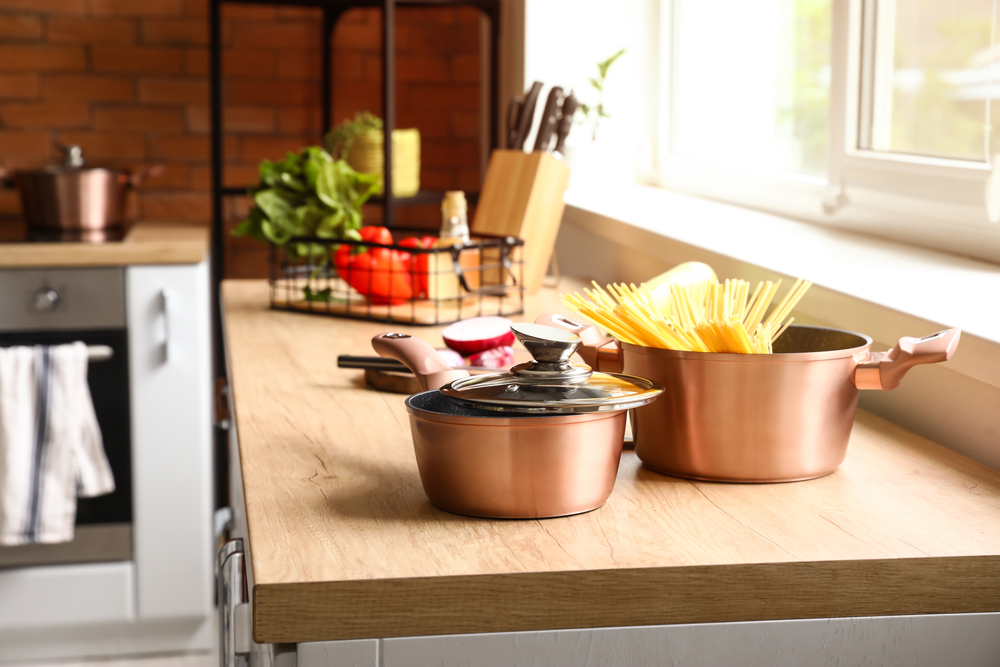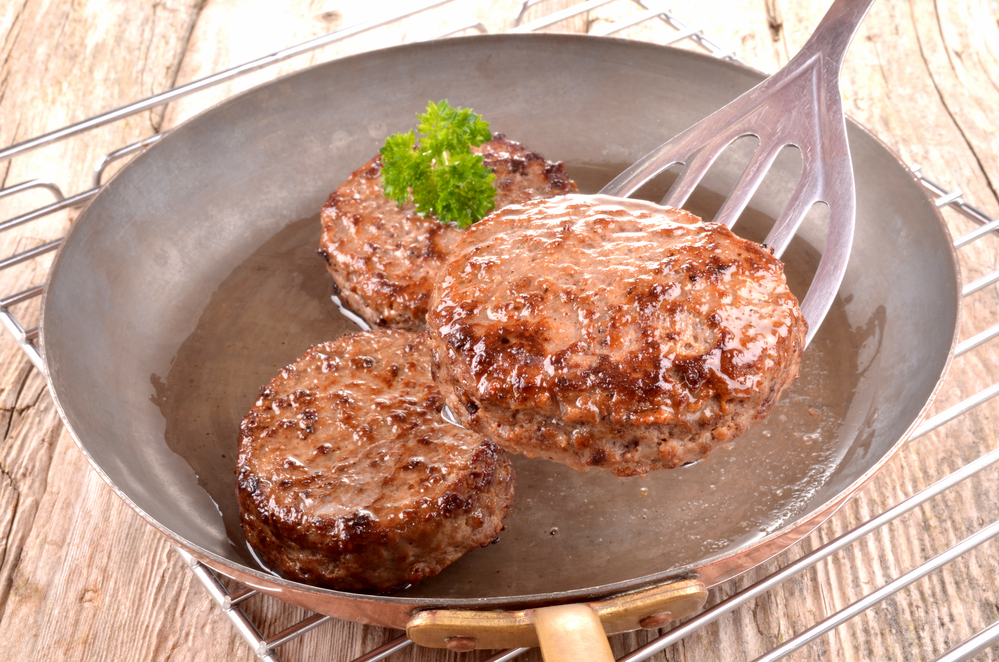Copper pots and pans are so attractive that you’ll often see them displayed beautifully in magazine photoshoots for the perfect kitchen. But apart from looking nice, why is copper used to make cooking pans?
We will look at what makes copper such a good material for cookware. We’ll consider all of the benefits, including how copper’s superior heat conductivity can make cooking more efficient. We will also see if there are any disadvantages to using copper cookware.
What Are the Benefits of Copper Cookware?
You’ll frequently see copper pans in professional kitchens where cooking performance is the overriding requirement. Let’s look at the benefits of a copper pan to your cooking.
Copper Conducts Heat Really Well
Copper is one of the best conductors of heat that you can find. It is actually second only to silver, which is too expensive to use for cookware. The excellent thermal conductivity of copper means heat from your hob is rapidly and equally distributed across the entire pan base, which allows the food to cook evenly.
Cast iron, aluminium, and stainless steel pans are less effective at transferring and spreading heat evenly. Accordingly, you’ll probably get hot and cooler temperature spots in your pan depending on how it’s sitting on your hob, leading to uneven cooking.
In addition, because copper cookware conducts an even heat so well, it responds rapidly as you adjust the stovetop temperature. While this might not be a problem for all foods, cooking sensitive ingredients such as lean meats, making delicate sauces, making jam or melting chocolate can make the difference between success and failure.
While cookware made entirely from copper is not that common in everyday kitchens, you will see quality pans with copper bases to take advantage of the vital heat distributing property where it matters most.
Copper Pots Are the Ideal Weight
For many chefs, copper cookware is preferred as they have a comfortable weight to cook with. Copper pots tend to be sufficiently heavy that they sit stably on the stove yet are light enough to make sauteing and frying easy.
Your Copper Pot Is Easy to Clean and Care For
Compared to many materials, including cast iron, most copper cookware is relatively easy to clean without much elbow grease. In general, you will only need to wash your copper pan with dishwashing liquid, rinse it with water and dry it with a soft cloth.
If your copper pan gets tarnished, you can easily clean it using a gentle mix of lemon juice and baking soda. Rubbing this on with a clean cloth will quickly bring back the beautiful natural copper finish.
Copper Is Highly Durable and Corrosion Resistant
Copper won’t rust and is exceptionally hard-wearing. It is actually common for copper cookware to be passed down in families, such as its longevity.
Copper Is Anti-Microbial
Copper has anti-microbial properties meaning that bacteria and other microbes can’t survive on it. This makes it ideal for use in kitchens where hygiene is paramount.
Copper Pots Are More Attractive
It is impossible to deny that copper pots and pans are attractive. A shiny set of brightly coloured copper cookware is a beautiful addition to any kitchen. You’ll want to display them proudly rather than hide them away.
What Are the Disadvantages of Copper Pots?
When asking, ‘why is copper used to make cooking pans?’, we also need to consider if they hold any disadvantages.
Copper Is a Reactive Metal
Copper is a naturally occurring chemical element essential for the health of our bodies. Copper is vital for brain health, is used during energy production, and is needed to metabolise iron and synthesise tissue.
However, while we need copper in our diets, getting too much of it could cause toxic stomach issues and liver damage. This is, however, exceedingly rare, and we don’t need to be overly concerned with using copper cookware so long as we use some sensible levels of caution.
Solid copper cookware is not that common now. What is more usual is to have copper pans lined with a thin layer of another metal. This layer of tin, zinc, nickel, aluminium or stainless steel stops copper from leaching into your food while still offering the many benefits that we have talked about.

Copper cookware that is currently available is typically lined with either tin or stainless steel. A tin lining is non-stick. However, it has a low melting point meaning that you can’t use a tin-lined copper pan above 200 degrees centigrade. While this sounds high, it is entirely achievable on the stove.
If you have tin-lined cookware, it should never be heated empty, and you shouldn’t use it for high-heat searing or sizzling.
Lining copper cookware with stainless steel is by far the most common nowadays. While the stainless lining isn’t great as a non-stick coating, stainless steel doesn’t have any melting problems and is entirely unreactive.
It is essential to check the lining of copper cookware to ensure it’s not damaged and could leak copper into the food. For that reason, it’s best not to aggressively scrub the lining and risk damaging it. Tin is particularly soft, so extra care should be taken when cleaning it.
Don’t store food in copper cookware, and pay particular attention to acidic food, which might attack the lining. If you have an old solid copper pan, it’s best not to use them with any food with a pH lower than 6.0. This would include wine, fruit juices and vinegar.
Copper Cookware Is Not Dish-Washer Safe
In general, you cannot clean copper cookware in the dishwasher. The strong chemicals used in a dishwasher might remove the attractive shine from your pots and cause discolouration. It could also damage the very thin layer of metal inside the pot, causing copper to leach into your food the next time you use it.
A copper pot washed in a dishwasher will likely end up with a tarnished and scratched appearance, so if you want to keep your investment looking its best, handwashing is the way to go.
Copper Cookware May Not Work With Induction Hobs
Induction cooking uses electromagnetic fields to generate heat inside the base of the pan. The pots and pans need to contain suitably magnetic metal to do this. Copper pans, unfortunately, do not have this property.
This means that copper cookware has to be specially designed to work with induction hobs and incorporate thick stainless steel layers to allow heat transfer to take place.
Typically copper in the base of the pan will be sandwiched between stainless steel to enable the induction process to work together with the heat spreading property of the copper.
Choosing Your Copper Cookware

When selecting your copper cookware, there are a few things that you’ll want to assess to make sure that you’re choosing the right pot.
Check the thickness of the metal material. As copper is one of the more relatively expensive metals, it’s normal for better quality pans to cost more.
The ideal copper thickness is about 2.5mm, which perfectly balances heat transmission with temperature control. Any thicker than this, the pan will take longer to heat up and will retain temperature for more time which might not be ideal.
A stainless steel lining is usually a better material than a tin one due to the tin’s low operating temperature and relative fragility.
Make sure that you consider the handles on the pans before making your purchase. Copper pans can have metal or wooden handles. Evaluate the comfort, grip and support of the handles to ensure that they will be appropriate.
Get Copper Pans for Your Kitchen
We’ve seen that the main reason copper is used in making cooking pans is to take advantage of the metal’s excellent heat conducting properties. Copper pans transmit the heat from your hob evenly and cook the food without cold or hot spots.
Copper pans also allow for fine temperature control as they respond quickly to any adjustments you make, which can be vital for the success of delicate cooking.
Copper does have some disadvantages, and modern pans will have a thin layer of another metal inside them to prevent any risk of copper leaching into your food and causing health problems. You’ll have to look after your copper pans a little more than regular ones, and you can’t put them in the dishwasher.
However, it’s undeniable that a set of copper cookware is a beautiful addition to your kitchen, and you will want to display the material for everyone to see.

